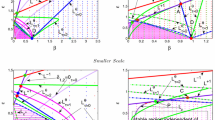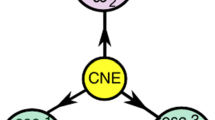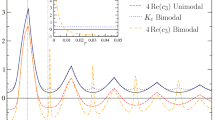Abstract
Motivated by the dynamics of neuronal responses, we analyze the dynamics of the FitzHugh–Nagumo slow–fast system with delayed self-coupling. This system provides a canonical example of a canard explosion for sufficiently small delays. Beyond this regime, delays significantly enrich the dynamics, leading to mixed-mode oscillations, bursting and chaos. These behaviors emerge from a delay-induced subcritical Bogdanov–Takens instability arising at the fold points of the S-shaped critical manifold. Underlying the transition from canard-induced to delay-induced dynamics is an abrupt switch in the nature of the Hopf bifurcation.












Similar content being viewed by others
Notes
Indeed, the solutions to the characteristic equation are given by the Lambert functions \(W_k\) (the different branches of the inverse of \(x\mapsto xe^x\), see, e.g., Corless et al. 1996):
$$\begin{aligned} \xi = A+\frac{1}{\tau } W_k\left( -\tau J e^{-\tau A}\right) \end{aligned}$$with \(A=1-(x^*)^2+J\). The stability of \(x^*\) is hence governed by the sign of the real part of the rightmost eigenvalue, given by the real branch \(W_0\) of the Lambert function, and if the argument of the Lambert function has a real part greater than \(-e^{-1}\), the root is unique. If not, we have two eigenvalues with the same real part corresponding to \(k=0\) or \(-1\).
The proof of existence of such a manifold is beyond the scope of this paper.
In the vicinity of the fixed point after the Hopf bifurcation, it is clear that the expansion rate in the delayed system becomes very large because of the separation of trajectories between those converging to fixed points and to the periodic orbit.
References
Baer, S.M., Erneux, T.: Singular Hopf bifurcation to relaxation oscillations. SIAM J. Appl. Math. 46(5), 721–739 (1986)
Benoit, E., Callot, J., Diener, F., Diener, M., et al.: Chasse au canard (première partie). Collectanea Mathematica 32(1), 37–76 (1981)
Bernardo, L., Foster, R.: Oscillatory behavior in inferior olive neurons: mechanism, modulation, cell aggregates. Brain Res. Bull. 17, 773–784 (1986)
Brøns, M., Krupa, M., Wechselberger, M.: Mixed mode oscillations due to the generalized canard phenomenon. Fields Inst. Commun. 49, 39–63 (2006)
Burke, J., Desroches, M., Barry, A.M., Kaper, T.J., Kramer, M.A., et al.: A showcase of torus canards in neuronal bursters. J. Math. Neurosci. 2(3), (2012). doi:10.1186/2190-8567-2-3
Campbell, S., Stone, E., Erneux, T.: Delay induced canards in high speed machining. Dyn. Syst. 24(3), 373–392 (2009)
Campbell, S.A.: Calculating centre manifolds for delay differential equations using maple. In: Delay Differential Equations, pp. 1–24. Springer (2009)
Chiba, H.: Periodic orbits and chaos in fast-slow systems with Bogdanov–Takens type fold points. J. Differ. Equ. 250, 112–160 (2011)
Corless, R., Gonnet, G., Hare, D., Jeffrey, D., Knuth, D.: On the lambertw function. Adv. Comput. Math. 5(1), 329–359 (1019–7168) (1996)
Desroches, M., Guckenheimer, J., Krauskopf, B., Kuehn, C., Osinga, H., Wechselberger, M.: Mixed-mode oscillations with multiple time scales. SIAM Rev. 54(2), 211–288 (2012)
Drover, J., Rubin, J., Su, J., Ermentrout, B.: Analysis of a canard mechanism by which excitatory synaptic coupling can synchronize neurons at low firing frequencies. SIAM J. Appl. Math. 65(1), 69–92 (2004)
Dumortier, F., Roussarie, R.H.: Canard Cycles and Center Manifolds, vol. 577. American Mathematical Society, Providence (1996)
Engelborghs, K., Luzyanina, T., Roose, D.: Numerical bifurcation analysis of delay differential equations using dde-biftool. ACM Trans. Math. Software (TOMS) 28(1), 1–21
Engelborghs, K., Luzyanina, T., Samaey, G.: Dde-biftool v. 2.00: a matlab package for bifurcation analysis of delay differential equations. Technical Report TW-330, Department of Computer Science, K.U.Leuven, Leuven, Belgium (2001)
Ermentrout, G., Terman, D.: Mathematical foundations neuroscience 35, (2010). doi:10.1007/978-0-387-87708-2
Ermentrout, G.B., Wechselberger, M.: Canards, clusters, and synchronization in a weakly coupled interneuron model. SIAM J. Appl. Dyn. Syst. 8(1), 253–278 (2009)
Faria, T., Magalhães, L.: Normal forms for retarded functional differential equations and applications to the bogdanov-takens singularity. J. Differ. Equ. 122, 201–224 (1995)
Faria, T., Magalhães, L.T.: Normal forms for retarded functional differential equations with parameters and applications to hopf bifurcation. J. Differ. Equ. 122(2), 181–200 (1995)
Fenichel, N.: Geometric singular perturbation theory for ordinary differential equations. J. Differ. Equ. 31(1), 53–98 (1979)
FitzHugh, R.: Mathematical models of threshold phenomena in the nerve membrane. Bull. Math. Biol. 17(4), 257–278 (0092–8240) (1955)
Friart, G., Weicker, L., Danckaert, J., Erneux, T.: Relaxation and square-wave oscillations in a semiconductor laser with polarization rotated optical feedback. Opt. Express 22(6), 6905–6918 (2014)
Guckenheimer, J., Holmes, P.J.: Nonlinear Oscillations, Dynamical Systems and Bifurcations of Vector Fields, vol. 42. Applied Mathematical Sciences, Springer, Berlin (1983)
Guckenheimer, J., Osinga, H.M.: The singular limit of a Hopf bifurcation. Disc. Contin. Dyn. Syst. Ser. A 32(8), 2805–2823 (2012)
Hale, J., Lunel, S.: Introduction to Functional Differential Equations. Springer, Berlin (1993)
Higuera, M., Knobloch, E., Vega, J.: Dynamics of nearly inviscid faraday waves in almost circular containers. Phys. D 201(1), 83–120 (2005)
Hupkes, H.J., Sandstede, B.: Traveling pulse solutions for the discrete FitzHugh-Nagumo system. SIAM J. Appl. Dyn. Syst. 9(3), 827–882 (2010)
Izhikevich, E.: Neural excitability, spiking, and bursting. Int. J. Bifurc. Chaos 10, 1171–1266 (2000)
Jones, C.K.: Geometric singular perturbation theory. In: Dynamical systems, pp. 44–118. Springer (1995)
Kandel, E.R., Schwartz, J.H., Jessell, T.M., et al.: Principles of Neural Science, vol. 4. McGraw-Hill, New York (2000)
Koper, M.: Bifurcations of mixed-mode oscillations in a three-variable autonomous van der pol-duffing model with a cross-shaped phase diagram. Phys. D 80(1), 72–94 (1995)
Kozyreff, G., Erneux, T.: Singular hopf bifurcation in a differential equation with large state-dependent delay. Proc. R. Soc. A Math. Phys. Eng. Sci. 470(2162), 20130,596 (2014)
Krupa, M., Touboul, J.: Canard explosion in delayed equations with multiple timescales. arXiv preprint arXiv:1407.7703 (2014)
Kuznetsov, Y.: Elements of applied bifurcation theory 112, (1995). doi:10.1007/978-1-4757-3978-7
Mallet-Paret, J., Nussbaum, R.D.: Global continuation and asymptotic behaviour for periodic solutions of a differential-delay equation. Annali di Matematica 145(1), 33–128 (1986)
Mischler, S., Quininao, C., Touboul, J.: On a kinetic FitzHugh-Nagumo model of neuronal network. arXiv:hal-01108872 (2015)
Nagumo, J., Arimoto, S., Yoshizawa, S.: An active pulse transmission line simulating nerve axon. Proc. IRE 50(10), 2061–2070 (1962)
Plant, R.E.: A FitzHugh differential-difference equation modeling recurrent neural feedback. SIAM J. Appl. Math. 40(1), 150–162 (1981)
Rinzel, J.: A formal classification of bursting mechanisms in excitable systems. In: Mathematical Topics in Population Biology, Morphogenesis and Neurosciences, pp. 267–281. Springer (1987)
Rinzel, J., Ermentrout, G.B.: Analysis of neural excitability and oscillations. In: Methods of Neuronal Modeling, pp. 251–292. MIT Press (1998)
Rubin, J., Wechselberger, M.: Giant squid-hidden canard: the 3D geometry of the Hodgkin-Huxley model. Biol. Cybern. 97(1), 5–32 (2007)
Sherman, A., Rinzel, J., Keizer, J.: Emergence of organized bursting in clusters of pancreatic beta-cells by channel sharing. Biophys. J. 54(3), 411–425 (1988)
Simpson, D.J., Kuske, R.: Mixed-mode oscillations in a stochastic, piecewise-linear system. Phys. D 240(14), 1189–1198 (2011)
Stewart, I., Golubitsky, M., Pivato, M.: Symmetry groupoids and patterns of synchrony in coupled cell networks. SIAM J. Appl. Dyn. Syst. 2(4), 609–646 (2003)
Stone, E., Campbell, S.A.: Stability and bifurcation analysis of a nonlinear dde model for drilling. J. Nonlinear Sci. 14(1), 27–57 (2004)
Terman, D.: Chaotic spikes arising from a model of bursting in excitable membranes. SIAM J. Appl. Math. 51(5), 1418–1450 (1991)
Touboul, J.: Limits and dynamics of stochastic neuronal networks with random delays. J. Stat. Phys 149(4), 569–597 (2012)
Touboul, J., Hermann, G., Faugeras, O.: Noise-induced behaviors in neural mean field dynamics. SIAM J. Dyn. Syst. 11(1), 49–81 (2012)
Touboul, J., Krupa, M., Desroches, M.: Noise-induced canard and mixed-mode oscillations in large stochastic networks with multiple timescales. arXiv preprint arXiv:1302.7159 (2013)
Van der Pol, B.: On relaxation-oscillations. Lond Edinb Dublin Philos. Mag. J. Sci. 2(11), 978–992 (1926)
Weicker, L., Erneux, T., D’Huys, O., Danckaert, J., Jacquot, M., Chembo, Y., Larger, L.: Strongly asymmetric square waves in a time-delayed system. Phys. Rev. E 86(5), 055201 (2012)
Weicker, L., Erneux, T., D’Huys, O., Danckaert, J., Jacquot, M., Chembo, Y., Larger, L.: Slow–fast dynamics of a time-delayed electro-optic oscillator. Philos. Trans. R. Soc. A Math. Phys. Eng. Sci. 371(1999), 20120459 (2013)
Zhang, W., Kirk, V., Sneyd, J., Wechselberger, M.: Changes in the criticality of hopf bifurcations due to certain model reduction techniques in systems with multiple timescales. The Journal of Mathematical Neuroscience (JMN) 1(1), 1–22 (2011)
Author information
Authors and Affiliations
Corresponding author
Ethics declarations
Conflict of interest
The authors declare that they have no conflict of interest and that they have complied with ethical standards.
Additional information
Communicated by Sue Ann Campbell.
Appendices
Appendix 1: Normal Form Reduction at Hopf Bifurcation
In Sects. 2.1 and 3, we have identified parameters for which the linearized equation at a fixed point, respectively of the full system (1) or of its fast subsystem, has a pair of purely imaginary eigenvalues. This provides us with the locus of possible Hopf bifurcations, and we show here aided by numerical evaluations that the system undergoes generic Hopf bifurcations. To this end one needs to reduce the system to normal form on the center manifold. This appendix is devoted to providing the outline of the method, in the context of the full system (slightly more complex than the fast one), and along the branch of Hopf bifurcations given by the first branch \(\tau =\tau _1^0(J,\varepsilon ,a)\) for \(a\in (1,\sqrt{1+2J})\), defined in Eq. (4). This curve corresponds to a change of stability of the fixed point \((a,a-a^3/3)\). We showed that as \(\varepsilon \rightarrow 0\), the curve collapses to a nonsmooth curve made of a segment \(\{J\tau <1, a=1\}\) and the curve of Hopf bifurcations of the fast system \(\tau (a)\) given by Eq. (16). We further showed that for when \(\varepsilon \rightarrow 0\), the Hopf bifurcation corresponding to \(J\tau <1\) is supercritical, and otherwise subcritical.
We confirm this change of criticality of the Hopf bifurcation for \(\varepsilon >0\) by reducing the system to normal form reduction along the Hopf bifurcation manifold. We follow a relatively standard tradition exposed for instance for delayed differential equations in Hale and Lunel (1993) and reviewed in Campbell (2009). We outline the method and calculations performed aided by the formal calculations software Maple®, before presenting the obtained coefficients and their shape as a function of the parameters.
This method is based on considering the delay differential Eq. (1) as a dynamical system in the Banach space X of continuous functions from \([-\tau ,0]\) to \(\mathbb {R}^2\) endowed with the uniform norm.
where \(\vert z(t)\vert \) is the Euclidian norm on \(\mathbb {R}^2\) of the value of the function \(z\in X\) at time \(t\in [-\tau ,0]\). The delayed differential equation is expressed as a functional differential equation on this space. Indeed, defining now \(z_t \in X\) as the portion of solution \((x(t),y(t),t\in [t-\tau ,t])\), with the definition
we can rewrite Eq. (1) as:
and similarly,
The terms within the brackets are the affine part of the flow, separated from the nonlinear cubic term in the equation on the first variable, which does not involve delays. Calculations are much simplified when changing variables so that the equilibrium is at the origin. This change of variable simply amounts changing the origin, i.e., consider the equation in terms of \(\tilde{x}=x-x^*\). The equations now read:
The linear operator decomposes into a part only depending on \(\tilde{z}_t(0)\):
and an operator depending on \(\tilde{x}_t(-\tau )\):
At Hopf bifurcation points, i.e., when the characteristic equation
has a complex solution \(\lambda =\pm \mathbf {i}\omega \), a complex right eigenvector is:
which corresponds to a two-dimensional center eigenspace N:
and an infinite-dimensional stable eigenspace S. The corresponding center manifold is given by:
where \(u=(u_1,u_2)^t\) are the coordinates on the nullspace N and \(h(u)\in S\). Classically, we project the solutions to the delay differential equation on \(\mathcal {M}\) and obtain:
where the \(h_{jk}^i\) characterize the Taylor expansion of the solution on the center manifold. These coefficients satisfy a system of affine ODEs, in which the affine term depends on the orthogonal basis of the nullspace, denoted \(\psi (\theta )\) (which is straightforward to calculate) arising from the projection of the original equation on N. These are now classical methods, introduced and used in Campbell (2009), Stone and Campbell (2004), Faria and Magalhães (1995). In our case, the solution to the linear ordinary differential equation of \(h_{jk}^i\) yields relatively complex expressions, in terms of six constants \(C_1\cdots C_6\) that are then solved in order to match boundary values (and solve the original DDE on the center manifold). One finds:
and similar expressions for the other terms, and it is not hard to determine the constants. From these expressions, we obtain a system of ODEs describing the evolution in time of u:
with G a cubic polynomial, whose coefficients can be deduced from the evaluation of \(h_{jk}^i\) and \(C_i\), and the first Lyapunov coefficient, characterizing the type of the Hopf bifurcation, is a simple function of these coefficients. With the help of the formal calculations software Maple®, we compute all these coefficients analytically. It happens that, as of quadratic terms, only the coefficients of \(u_1^2\) in \(G_1\) and \(G_2\) are nonzero, and cubic coefficients involved in the computation of the Lyapunov coefficients enjoy a relatively simple form. These coefficients are given by:
where the dots correspond to terms that are not necessary to compute the first Lyapunov coefficient. From this expression, classical formulae (see, e.g., Kuznetsov 1995) yield a very complex expression for the first Lyapunov coefficient as a function of the parameters (Fig. 13). This expression is, however, exact and allows direct numerical computation of the Lyapunov coefficient that we presented in Sect. 2.2.
Appendix 2: The FitzHugh–Nagumo System with \(\gamma \ne 0\)
In this appendix, we provide one numerical example of delayed self-coupled FitzHugh–Nagumo system (8) with \(\gamma \ne 0\) that has similar dynamics as the ones studied in the main text, i.e., for \(\gamma \) small enough.
The fixed points of the system are given by \(y=(x-a)/\gamma \), where x is the solution of the cubic polynomial:
This equation can be solved using Cardano method, exactly as we solve the cubic equation of the fast system. In detail, the Cardano discriminant of the equation writes:
when \(\Delta >0\), the system has a unique solution:
and when \(\Delta <0\), we find 3 roots:
The stability of the fixed points can be analyzed in a similar fashion as done before. In that case, denoting by \(x_*\) one of the equilibria found, the dispersion relationship corresponds to the determinant of the matrix:
with \(A=1-(x_*)^2 +J (1-e^{-\xi \tau })\), and the dispersion relationship therefore reads:
or:
This appears much more complex to solve in closed form.
The fast dynamics is identical as that of the delayed FhN system, and therefore, the analysis of Sect. 3 applies. This allows to account for most of the behaviors of the FhN system. The only phenomenon requiring some more work is the presence of canard explosion and their type. Similar to the nondelayed case, the details of the slow dynamics matter for the demonstration of the presence of canard explosions. Here, we provide numerical evidences for canard explosion and show that similar phenomena of emergence of mixed-mode oscillations and bursting appear, for the same values of parameters, in the parameter regime where FhN system has a unique fixed point. Let us for instance consider the FhN model for \(b=-1\) and \(\gamma =-0.3\). We set \(a=0.85\) (which leads the system to a similar situation as studied in the FhN system with \(a=1.01\)). For \(\tau >1/J\), we have seen that geometric analysis of the fast system accounted for most phenomena arising in the FhN system. This property persists for the FitzHugh–Nagumo system, and we therefore observe the very same behaviors and transitions at similar delays.
Rights and permissions
About this article
Cite this article
Krupa, M., Touboul, J.D. Complex Oscillations in the Delayed FitzHugh–Nagumo Equation. J Nonlinear Sci 26, 43–81 (2016). https://doi.org/10.1007/s00332-015-9268-3
Received:
Accepted:
Published:
Issue Date:
DOI: https://doi.org/10.1007/s00332-015-9268-3





